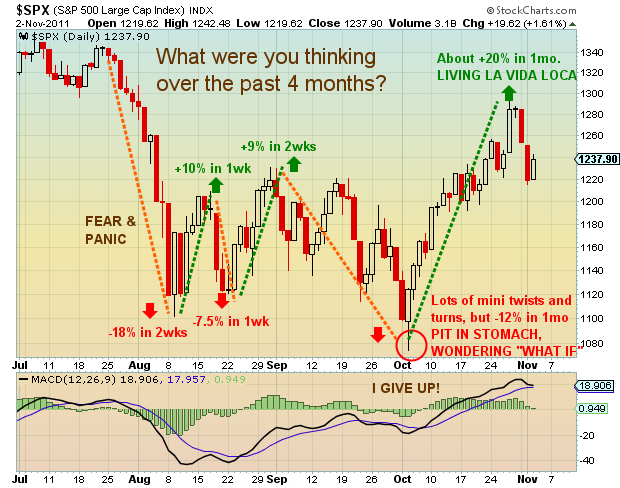By Andrew Nyquist
When financial markets become frantic and heavily emotional, what is your stomach like? Do you connect with that pit in your stomach and sell because “you can’t take it anymore?” Or on the other end of the spectrum, do you get so caught up in celebrating your gains that you forget to take action and “bank some profits.” The ability to see through your fear and greed is the single most important investment trait to hone if you want to take your investing game to a new level.
Now I’m not here to tell you that your emotions are wrong or unnatural. On the contrary, I’m right there with you. Our money is our money, and it’s important. And our pride is our pride, and we all have egos to preserve. This is why we feel like high fiving when the markets are up and the news is great, and throwing up when the markets are diving lower. And the more money you have at risk, the more emotional you can become.
So how do we learn to detach ourselves from our emotions so we can make better investment decisions? Well I have a few ideas to help you with this but a little humor and graphic illustration will do the trick first (see below).
As you can see, the markets have been extremely volatile over the past 4 months. And, although this is an extreme case of despair and euphoria, it gets at my point. In the investing world, both ends of the emotional spectrum tend to screw the “weak hands.” The weak hands are those that let their emotions get the best of them. And these folks tend to be amateur, retail investors. In short, when the markets are burning hot, mom and pops want in, and when the markets are doing poorly, they want out. They lose their rationality and fail to remember that it’s “buy low and sell high.” Unfortunately, emotional investing can lead to poor investment decisions. And being off by just a few percent each year can lead to a large sum of money down the road (i.e. retirement).
That being said, here are 4 things that you can do to help you keep better tabs on your emotions:
1) Have an investment plan. It doesn’t matter if it’s a stock or mutual fund nor whether you are a short or long term investor. You need to have an idea of the price at which a given security is a good buy, a price range where you would buy more of that security, and a plan for exiting (for gain or loss). It is much easier to put a plan together at the time of purchase as opposed to down the road when excuses and mental requests for “a little more rope” take over. Don’t forget to dollar cost average.
2) Learn the basics of technical analysis. This can make/save you a lot of money. Understanding how to identify trendlines and support and resistance will give you a leg up on other investors. (More on this in The Anatomy of a Trader, Part 3)
3) Revel in your rationality. Stay on top of your investments and continue to focus on your exit points. Remember that profits are only “on paper” until you hit the sell button. Also remember that selling for a loss isn’t the worst thing in the world; it can save you a lot of pain down the road, especially if the sale comes after the break of a key support level. Learning more about technical analysis will help you identify levels to set sell stops. Being rational also means investing with funds that you can afford to take losses on — keep “rainy day” cash alive and well.
4) Start an investment diary. Keep track of each transaction, marking down the date, price, and action taken. If you are recording a sale, be sure to record your gain or loss. Accountability is extremely important in any endeavor if you want to become the best. Don’t forget to add a few notes on the news, general feel in the air, and what you were thinking when you made the transaction. More on this in The Anatomy of a Trader, Part 4).
We’re all capable of learning more each and every day. So don’t be afraid of putting yourself to the test. Now is the time. Now is your time.
Keep and eye out for Part 3 of the series next week. Click here to read Part 1: Brain Basics. Have a great rest of your week.
***Find the entire The Anatomy of a Trader series here.
———————————————————
Your comments and emails are welcome. Readers can follow me on Twitter on @andrewnyquist. For current news and updates, be sure to “Like” See It Market on Facebook. Thank you.
Any opinions expressed herein are solely those of the author, and do not in any way represent the views or opinions of his employer or any other person or entity.









